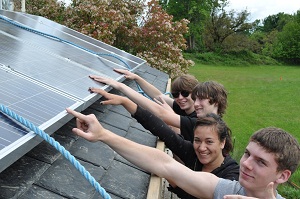Carson City School District ready to install nearly 2 MWs of solar
 Nevada’s Carson City School District is preparing to break ground on an $11 million project to install 1.95 megawatts (MW) of photovoltaics at 5 schools. Most recently the district won a lawsuit that alleged it had not properly bid the projects out.
Nevada’s Carson City School District is preparing to break ground on an $11 million project to install 1.95 megawatts (MW) of photovoltaics at 5 schools. Most recently the district won a lawsuit that alleged it had not properly bid the projects out.
The Northern Nevada Building and Construction Trades Council filed a petition with the Carson City District Court to halt progress on the project, alleging that the school district did not properly bid out the project. On Dec. 30, 2010, Carson City District Court Judge Deborah Agosti ruled that the district’s joint bid with Sparks, Nev., was legal under Nevada state law.
The project is expected to cost the school a total of $950,000 after receiving solar energy rebates for roughly 92 percent of the project from NV Energy. The installations should save the school district $400,000 in annual electric costs.
The district plans to install a 1-MW system at a high school; three, 300 kilowatt systems at three other schools; and a 50 kW shade structure system at one school, said Anthony Turley, director of fiscal services for the school district.
“Most of the systems,” he said, “are ground mount systems.”
The district opted for ground-mounted PV systems, for a number of reasons, Turley said.
“Most roofs are not structurally set up for solar nor do they face the right direction,” he said.
He added that the district did have adequate field capacity for the installations.
The ground-mounted systems are facing opposition from some community members.
Chief among them is Paul Eastwood. His appeal will be heard by city’s supervisory board on Thursday. He’s appealing against Carson City’s decision to grant the school system a special use permit to install an array on land behind Seeliger Elementary School.
The school has about four acres of open space behind it, Turley said.
“Paul Eastwood lives near that specific school site,” he said.
Eastwood’s appeal, Turley said, alleges that the school system did not meet certain criteria in permitting the project.
“He’s been against it from the start,” he said. “We had public meetings, and he expressed his displeasure at them.”
To appease Eastwood, the district made modifications to the proposed photovoltaic array, including moving it back by 90 feet from the property’s edge, lowering the height of the project, fencing it in and creating a natural and educational area, Turley said.
The district is confident that the school district’s solar project will gain approval from the board.
“We have support of their staff,” he said.
Pictured: A school installation at Falls City, Ore., courtesy of the Solar 4R Schools project.



